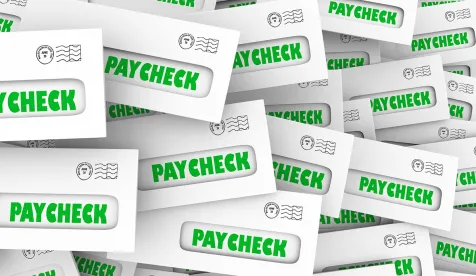The U.S. Department of Treasury just released guidance (the “Guidance”) on how to calculate the maximum loan amount for the PPP. The Guidance splits out the calculation by business entity type. Much of the calculation is focused on 2019 tax returns. Additionally, the Guidance notes that documentation demonstrating that the business was in operation as of February 15, 2020 is required. Read the full guidance here. Alternately full text is below:
April 24, 2020
PAYCHECK PROTECTION PROGRAM
HOW TO CALCULATE MAXIMUM LOAN AMOUNTS – BY BUSINESS TYPE
The Small Business Administration (SBA), in consultation with the Department of the Treasury, is providing this guidance to assist businesses in calculating their payroll costs for purposes of determining the amount of a Paycheck Protection Program (PPP) loan businesses can apply for.
Borrowers and lenders may rely on the guidance provided in this document as SBA’s interpretation of the CARES Act and of the Paycheck Protection Program Interim Final Rules. The U.S. government will not challenge lender PPP actions that conform to this guidance1 and to the PPP Interim Final Rules and any subsequent rulemaking in effect at the time.
1. Question: I am self-employed and have no employees, how do I calculate my maximum PPP loan amount? (Note that PPP loan forgiveness amounts will depend, in part, on the total amount spent during the eight-week period following the first disbursement of the PPP loan.)
Answer: The following methodology should be used to calculate the maximum amount that can be borrowed if you are self-employed and have no employees, and your principal place of residence is in the United States, including if you are an independent contractor or operate a sole proprietorship (but not if you are a partner in a partnership):
- Step 1: Find your 2019 IRS Form 1040 Schedule C line 31 net profit amount (if you have not yet filed a 2019 return, fill it out and compute the value). If this amount is over $100,000, reduce it to $100,000. If this amount is zero or less, you are not eligible for a PPP loan.
- Step 2: Calculate the average monthly net profit amount (divide the amount from Step 1 by 12).
- Step 3: Multiply the average monthly net profit amount from Step 2 by 2.5.
- Step 4: Add the outstanding amount of any Economic Injury Disaster Loan (EIDL) made between January 31, 2020 and April 3, 2020 that you seek to refinance, less the amount of any advance under an EIDL COVID-19 loan (because it does not have to be repaid).
Your 2019 IRS Form 1040 Schedule C must be provided to substantiate the applied-for PPP loan amount. You must also provide a 2019 IRS Form 1099-MISC detailing nonemployee compensation received (box 7), invoice, bank statement, or book of record establishing you were self-employed in 2019 and a 2020 invoice, bank statement, or book of record establishing you were in operation on February 15, 2020.
2. Question: I am self-employed and have employees, how do I calculate my maximum PPP loan amount (up to $10 million)? (Note that PPP loan forgiveness amounts will depend, in part, on the total amount spent during the eight-week period following the first disbursement of the PPP loan.)
Answer: The following methodology should be used to calculate the maximum amount that can be borrowed if you are self-employed with employees, including if you are an independent contractor or operate a sole proprietorship (but not if you are a partner in a partnership):
- Step 1: Compute your 2019 payroll costs by adding the following:
- 2019 IRS Form 1040 Schedule C line 31 net profit amount (if you have not yet filed a 2019 return, fill it out and compute the value); if this amount is over $100,000, reduce it to $100,000; and if this amount is less than zero, set this amount at zero;
- 2019 gross wages and tips paid to your employees whose principal place of residence is in the United States, which can be computed using 2019 IRS Form 941 Taxable Medicare wages & tips (line 5c-column 1) from each quarter plus any pre-tax employee contributions for health insurance or other fringe benefits excluded from Taxable Medicare wages & tips, subtracting any amount paid to any individual employee in excess of $100,000 and any amounts paid to any employee whose principal place of residence is outside the U.S;
- 2019 employer contribution3 for employee health insurance (portion of IRS Form 1040 Schedule C line 14 attributable to health insurance);
- 2019 employer contributions to employee retirement plans (IRS Form 1040 Schedule C line 19); and
- 2019 employer state and local taxes assessed on employee compensation, primarily state unemployment insurance tax (from state quarterly wage reporting forms).
- Step 2: Calculate the average monthly payroll costs amount (divide the amount from Step 1 by 12).
- Step 3: Multiply the average monthly payroll costs amount from Step 2 by 2.5.
- Step 4: Add the outstanding amount of any EIDL made between January 31, 2020 and April 3, 2020 that you seek to refinance, less the amount of any advance under an EIDL COVID-19 loan (because it does not have to be repaid).
Your 2019 IRS Form 1040 Schedule C, IRS Form 941 and state quarterly wage unemployment insurance tax reporting form from each quarter (or equivalent payroll processor records or IRS Wage and Tax Statements), along with documentation of any retirement or health insurance contributions, must be provided to substantiate the applied- for PPP loan amount. A payrol
3. Question: I am a self-employed individual who reports my income on IRS Form 1040 Schedule F. What documentation must I provide in place of Schedule C and how should my maximum loan amount be determined (up to $10 million)?
Answer: Self-employed farmers (i.e., those who report their net farm profit on IRS Form 1040 Schedule 1 and Schedule F) should use IRS Form 1040 Schedule F in lieu of Schedule C, and Schedule F line 34 net farm profit should be used to determine their loan amount in place of Schedule C line 31 net profit. The calculation is otherwise the same as for Schedule C filers above. The 2019 IRS Form 1040 Schedule 1 and Schedule F must be included with the loan application.
4. Question: How do partnerships apply for PPP loans and how is the maximum PPP loan amount calculated for partnerships (up to $10 million)? Should partners’ self- employment income be included on the business entity level PPP loan application or on separate PPP loan applications for each partner? (Note that PPP loan forgiveness amounts will depend, in part, on the total amount spent during the eight-week period following the first disbursement of the PPP loan.)
Answer: The following methodology should be used to calculate the maximum amount that can be borrowed for partnerships (partners’ self-employment income should be included on the partnership’s PPP loan application, individual partners may not apply for separate PPP loans):
- Step 1: Compute 2019 payroll costs by adding the following:
- 2019 Schedule K-1 (IRS Form 1065) Net earnings from self-employment of individual U.S. based general partners that are subject to self-employment tax, computed from box 14a (reduced by any section 179 expense deduction claimed, unreimbursed partnership expenses claimed, and depletion claimed on oil and gas properties) multiplied by 0.9235,2 up to $100,000 per partner (if 2019 schedules have not been filed, fill them out);
- 2019 gross wages and tips paid to your employees whose principal place of residence is in the United States, if any, which can be computed using 2019 IRS Form 941 Taxable Medicare wages & tips (line 5c-column 1) from each quarter plus any pre-tax employee contributions for health insurance or other fringe benefits excluded from Taxable Medicare wages & tips, subtracting any amounts paid to any individual employee in excess of $100,000 and any amounts paid to any employee whose principal place of residence is outside theU.S;
- 2019 employer contributions for employee health insurance, if any (portion of IRS Form 1065 line 19 attributable to healthinsurance);
- 2019 employer contributions to employee retirement plans, if any (IRS Form 1065 line 18);and
- 2019 employer state and local taxes assessed on employee compensation, primarily state unemployment insurance tax (from state quarterly wage reporting forms), ifany.
- Step 2: Calculate the average monthly payroll costs (divide the amount from Step 1 by 12).
- Step 3: Multiply the average monthly payroll costs from Step 2 by 2.5.
- Step 4: Add any outstanding amount of any EIDL made between January 31, 2020 and April 3, 2020 that you seek to refinance, less the amount of any advance under an EIDL COVID-19 loan (because it does not have to be repaid).
The partnership’s 2019 IRS Form 1065 (including K-1s) and other relevant supporting documentation if the partnership has employees, including the 2019 IRS Form 941 and state quarterly wage unemployment insurance tax reporting form from each quarter (or equivalent payroll processor records or IRS Wage and Tax Statements) along with records of any retirement or health insurance contributions, must be provided to substantiate the applied-for PPP loan amount. If the partnership has employees, a payroll statement or similar documentation from the pay period that covered February 15, 2020 must be provided to establish the partnership was in operation and had employees on that date. If the partnership has no employees, an invoice, bank statement, or book of record establishing the partnership was in operation on February 15, 2020 must instead be provided.
5. Question: How is the maximum PPP loan amount calculated for S corporations and C corporations (up to $10 million)? (Note that PPP loan forgiveness amounts will depend, in part, on the total amount spent during the eight-week period following the first disbursement of the PPP loan.)
Answer: The following methodology should be used to calculate the maximum amount that can be borrowed for corporations, including S and C corporations:
- Step 1: Compute 2019 payroll costs by adding the following:
- 2019 gross wages and tips paid to your employees whose principal place of residence is in the United States, which can be computed using 2019 IRS Form 941 Taxable Medicare wages & tips (line 5c-column 1) from each quarter plus any pre-tax employee contributions for health insurance or other fringe benefits excluded from Taxable Medicare wages & tips, subtracting any amounts paid to any individual employee in excess of $100,000 and any amounts paid to any employee whose principal place of residence is outside theU.S;
- 2019 employer health insurance contributions (portion of IRS Form 1120 line 24 or IRS Form 1120-S line 18 attributable to healthinsurance);
- 2019 employer retirement contributions (IRS Form 1120 line 23 or IRS Form 1120-S line 17);and
- 2019 employer state and local taxes assessed on employee compensation, primarily state unemployment insurance tax (from state quarterly wage reporting forms).
- Step 2: Calculate the average monthly payroll costs (divide the amount from Step 1 by 12).
- Step 3: Multiply the average monthly payroll costs from Step 2 by 2.5.
- Step 4: Add the outstanding amount of any EIDL made between January 31, 2020 and April 3, 2020 that you seek to refinance, less the amount of any advance under an EIDL COVID-19 loan (because it does not have to be repaid).
The corporation’s 2019 IRS Form 941 and state quarterly wage unemployment insurance tax reporting form from each quarter (or equivalent payroll processor records or IRS Wage and Tax Statements), along with the filed business tax return (IRS Form 1120 or IRS 1120-S) or other documentation of any retirement and health insurance contributions, must be provided to substantiate the applied-for PPP loan amount. A payroll statement or similar documentation from the pay period that covered February 15, 2020 must be provided to establish you were in operation and had employees on that date.
6. Question: How is the maximum PPP loan amount calculated for eligible nonprofit organizations3 (up to $10 million)? (Note that PPP loan forgiveness amounts will depend, in part, on the total amount spent during the eight-week period following the first disbursement of the PPP loan.)
Answer: The following methodology should be used to calculate the maximum amount that can be borrowed for eligible nonprofit organizations (eligible nonprofit religious institutions, see the next question):
- Step 1: Compute 2019 payroll costs by adding the following:
- 2019 gross wages and tips paid to your employees whose principal place of residence is in the United States, which can be computed using 2019 IRS Form 941 Taxable Medicare wages & tips (line 5c-column 1) from each quarter plus any pre-tax employee contributions for health insurance or other fringe benefits excluded from Taxable Medicare wages & tips, subtracting any amounts paid to any individual employee in excess of $100,000 and any amounts paid to any employee whose principal place of residence is outside theU.S;
- 2019 employer health insurance contributions (portion of IRS Form 990 Part IX line 9 attributable to healthinsurance);
- 2019 employer retirement contributions (IRS Form 990 Part IX line 8);and
- 2019 employer state and local taxes assessed on employee compensation, primarily state unemployment insurance tax (from state quarterly wage reportingforms).
- Step 2: Calculate the average monthly payroll costs (divide the amount from Step 1 by 12).
- Step 3: Multiply the average monthly payroll costs from Step 2 by 2.5.
- Step 4: Add the outstanding amount of any EIDL made between January 31, 2020 and April 3, 2020 that you seek to refinance, less the amount of any advance under an EIDL COVID-19 loan (because it does not have to be repaid).
The nonprofit organization’s 2019 IRS Form 941 and state quarterly wage unemployment insurance tax reporting form from each quarter (or equivalent payroll processor records or IRS Wage and Tax Statements), along with the filed IRS Form 990 Part IX or other documentation of any retirement and health insurance contributions, must be provided to substantiate the applied-for PPP loan amount. A payroll statement or similar documentation from the pay period that covered February 15, 2020 must be provided to establish you were in operation and had employees on that date. Eligible nonprofits that do not file an IRS Form 990, typically those with gross receipts less than $50,000, should see the next question.
7. Question: How is the maximum PPP loan amount calculated for eligible nonprofit religious institutions, veterans organizations, and tribal businesses (up to $10 million)? (Note that PPP loan forgiveness amounts will depend, in part, on the total amount spent during the eight-week period following the first disbursement of the PPP loan.)
Answer: The following methodology should be used to calculate the maximum amount that can be borrowed for eligible nonprofit religious institutions, veterans organizations and tribal businesses:
- Step 1: Compute 2019 payroll costs by adding the following:
- 2019 gross wages and tips paid to your employees whose principal place of residence is in the United States, which can be computed using 2019 IRS Form 941 Taxable Medicare wages & tips (line 5c-column 1) from each quarter plus any pre-tax employee contributions for health insurance or other fringe benefits excluded from Taxable Medicare wages & tips, subtracting any amounts paid to any individual employee in excess of $100,000 and any amounts paid to any employee whose principal place of residence is outside theU.S;
- 2019 employer health insurancecontributions;
- 2019 employer retirement contributionsand
- 2019 employer state and local taxes assessed on employee compensation, primarily state unemployment insurance tax (from state quarterly wage reportingforms).
- Step 2: Calculate the average monthly payroll costs (divide the amount from Step 1 by 12).
- Step 3: Multiply the average monthly payroll costs from Step 2 by 2.5.
- Step 4: Add any outstanding amount of any EIDL made between January 31, 2020 and April 3, 2020 that you seek to refinance, less the amount of any advance under an EIDL COVID-19 loan (because it does not have to be repaid).
The entity’s 2019 IRS Form 941 and state quarterly wage unemployment insurance tax reporting form from each quarter (or equivalent payroll processor records or IRS Wage and Tax Statements), along with documentation of any retirement and health insurance contributions, must be provided to substantiate the applied-for PPP loan amount. A payroll statement or similar documentation from the pay period that covered February 15, 2020 must be provided to establish you were in operation and had employees on that date.
8. Question: I am an LLC owner. Which set of instructions apply to me?
Answer: LLCs should follow the instructions that apply to their tax filing situation, for example, whether they file as a sole proprietor, a partnership, or a corporation.
9. Question: What other documentation can be provided for the purpose of substantiating the applied-for PPP loan amount?
Answer: IRS Form W-2s and IRS Form W-3 or payroll processor reports, including quarterly and annual tax reports, can be used in place of IRS Form 941. Additionally, very small businesses that file an annual IRS Form 944 instead of quarterly IRS Form 941 should rely on and provide IRS Form 944. Similarly, records from a retirement administrator can be used to document employer retirement contributions while records from a health insurance company or third-party administrator for a self-insured plan can document employer health insurance contributions.
l This document does not carry the force and effect of law independent of the statute and regulations on which it is based.
2 This treatment follows the computation of self-employment tax from IRS Form 1040 Schedule SE Section A line 4 and removes the “employer” share of self-employment tax, consistent with how payroll costs for employees in the partnership are determined.
3 “Eligible nonprofit organization” means an organization that is described in section 501(c)(3) of the Internal Revenue Code of 1986 and that is exempt from taxation under
section 501(a) of such Code.





 />i
/>i
